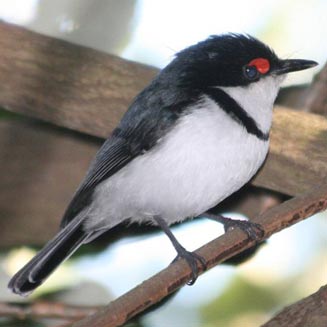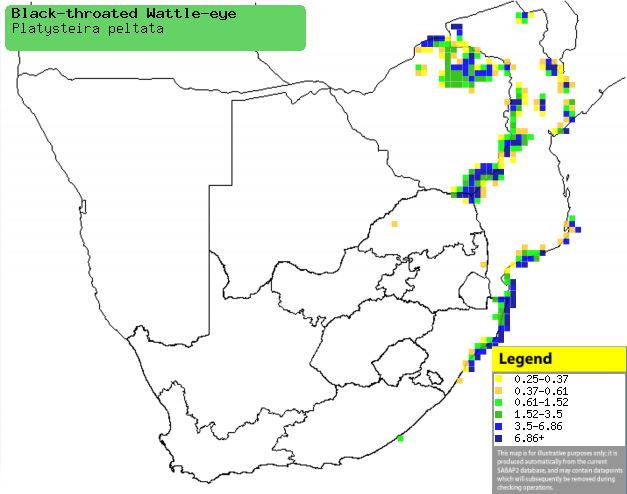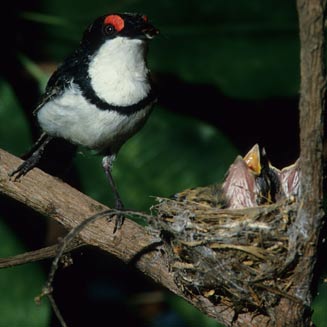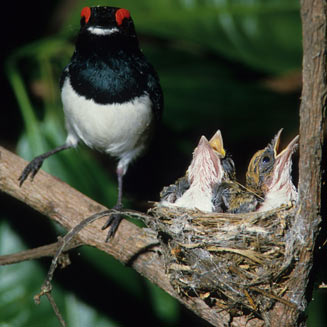|
Platysteira peltata
(Black-throated wattle-eye, Wattle-eyed flycatcher)
Beloogbosbontrokkie [Afrikaans];
Zwartkeel-lelvliegenvanger [Dutch]; Pririt à gorge noire [French];
Schwarzkehl-lappenschnäpper [German]; Olho-carunculado [Portuguese]
Life
> Eukaryotes >
Opisthokonta
> Metazoa (animals) >
Bilateria >
Deuterostomia > Chordata >
Craniata > Vertebrata (vertebrates) > Gnathostomata (jawed
vertebrates) > Teleostomi (teleost fish) > Osteichthyes (bony fish) > Class:
Sarcopterygii (lobe-finned
fish) > Stegocephalia (terrestrial
vertebrates) > Tetrapoda
(four-legged vertebrates) > Reptiliomorpha > Amniota >
Reptilia (reptiles) >
Romeriida > Diapsida > Archosauromorpha > Archosauria >
Dinosauria
(dinosaurs) > Saurischia > Theropoda (bipedal predatory dinosaurs) >
Coelurosauria > Maniraptora > Aves
(birds) >
Order: Passeriformes
> Family: Malaconotidae
 |
|
|
Black-throated wattle-eye male, Umhlanga,
KwaZulu-Natal, South Africa. [photo
Alan Manson
©] |
|
For information about this species, see
www.birdforum.net/opus/Black-throated_Wattle-eye Distribution and habitat
Occurs from Angola to Kenya south to southern Africa,
absent from the lowland forests of the DRC. In our region it is generally
uncommon, with populations scattered across Zimbabwe, Mozambique and
KwaZulu-Natal. It usually occupies Afromontane and coastal forest, often near a
river or stream with vegetation protruding into the water. It can also occur in
farm gardens, stands of tall trees with dense undergrowth, dune forest and
mangroves.
|
 |
|
Distribution of Black-throated wattle-eye in southern Africa,
based on statistical smoothing of the records from first SA Bird Atlas
Project (©
Animal Demography unit, University of
Cape Town; smoothing by Birgit Erni and Francesca Little). Colours range
from dark blue (most common) through to yellow (least common).
See here for the latest distribution
from the SABAP2. |
Brood parasites
It has been recorded as host of the
Green-backed honeybird.
Food
An extremely active insectivorous forager, it catches most
of its prey in the air, although it occasionally gleans them from leaves and
branches. It sometimes joins mixed species flocks, along with
Spectacled weavers,
Red-throated twinspots
and Terrestrial bulbuls.
The following food items have been recorded in its diet:
Breeding
- The female does most of the nest building work, making a cup out of fine
twigs and grass bound together with spider web (see images below). It is
usually placed in the fork of a bushy tree's branch, less often amongst the
tangled leaves of a creeper.
 |
 |
|
Black-throated wattle-eye male at its nest. [photo Peter Steyn
©] |
Black-throated wattle-eye female at its nest. [photo Peter Steyn
©] |
- Egg-laying season is from about September-January, peaking from
October-November.
- It typically lays 2 eggs, which are incubated solely by the female for
about 16-18 days; the male does all of the hunting. They are extremely
aggressive to intruders at the nest, attacking other birds, snakes and even
humans with their claws and beak.
- The chicks are are brooded by both sexes, although the female does most
of the work. The female also forages in the area around the nest while the
male hunts further afield, occasionally bringing food to her. The chicks
leave the nest at about 14-16 days old, after which they learn to hunt. Even
though they can fend for themselves, they still remain with their parents
for about 6 months more.
Threats
Near-threatened in South Africa, largely due to
habitat destruction. It is still well represented in protected areas however,
especially the Kruger National Park, Mkuzi Game Reserve and Greater St Lucia
Wetland Park
References
-
Hockey PAR, Dean WRJ and Ryan PG 2005. Roberts
- Birds of southern Africa, VIIth ed. The Trustees of the John Voelcker
Bird Book Fund, Cape Town.
|
